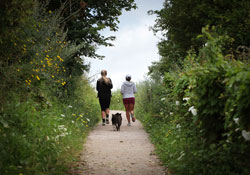WHO report shows urban green spaces deliver multiple health benefits

Victoria Tetley/VJT Photography
A new WHO report summarizing evidence on the health effects of green space in urban areas shows that green spaces offer numerous public health benefits, including psychological relaxation and stress reduction, enhanced physical activity and a potential reduction in exposure to – among other harmful urban factors – air pollution, noise and excessive heat. The report concludes that there is a need for both small, local green spaces situated very close to where people live and spend their day, and large green spaces that provide formal recreational facilities (such as playing fields) and opportunities to interact with nature.
The report also presents a toolkit for a geographic information system (GIS)-based approach to measuring urban green space. This provides cities with a way to calculate how many people have access to green spaces and to identify new areas where they can be established. WHO has already tested the tool in 3 European cities: Kaunas, Lithuania; Utrecht, Netherlands; and Malmö, Sweden. These case studies serve as examples of how to effectively use the tool to increase the benefits of green space for urban residents.
Social and economic benefits of green space
A city of well-connected, attractive green spaces can provide safe opportunities for urban residents to enjoy physical activity and recreation, recover from stress and share social contact. Green spaces also help to improve cities’ resilience to extreme environmental events such as heat waves (by mitigating the urban heat island effect) and extreme rainfall (by reducing surface run-off).
The evidence also demonstrates that green spaces bring particular benefits to economically deprived communities, children, pregnant women and senior citizens. Cities with green spaces are likely to have healthier citizens and therefore reduced demands on health services, which contributes to a stronger economy.
Moving the agenda forward
2 recent WHO meetings, both held in Bonn, Germany, have focused on the relevance of urban green spaces to health and have helped to move the agenda forward in this area.
The first meeting, held in June 2016, focused on the impact of green spaces on air pollution. Participants explored the possibility of developing a GIS-based tool that would help to quantify the contribution of urban green spaces to better air quality. WHO is currently carrying out a web-based survey of green space and health experts to identify research priorities and knowledge gaps that may inform further action.
The second meeting, held in September 2016, brought together experts, environmental researchers and city councillors to discuss the practical side of urban green space interventions. Participants agreed to produce a report on the relevance of urban green spaces from a health and equity perspective, emphasizing how local interventions can deliver positive results. They also recommended producing a policy brief for urban planners and policy-makers that would provide guidance on the effective use of urban green spaces for health and equity, support intersectoral cooperation and help local authorities shape healthy and sustainable urban settings.
Upcoming Ministerial Conference on Environment and Health
Urban green space relates directly to the priority theme of the Sixth Ministerial Conference on Environment and Health – “Cities”. The Conference, to be held on 13–15 June 2017 in Ostrava, Czechia, will bring together health and environment ministers and high-level representatives of WHO European Region Member States, partner organizations, academia and civil society. Member States are expected to adopt a ministerial declaration, an implementation plan for their commitments and a reformed governance mechanism for the European Environment and Health Process.
Political frameworks on green space and health
Two political frameworks specifically address the link between urban green space and health.
- The Parma Declaration commits by 2020 “to provide each child with access … to green spaces in which to play and undertake physical activity”.
- The 2030 Agenda for Sustainable Development, which pledges to “leave no one behind”, sets the target in Sustainable Development Goal 11.7 to “provide universal access to safe, inclusive and accessible, green and public spaces, in particular for women and children, older persons and persons with disabilities”.
The topic of urban green space is also embedded in the priority area “creating resilient communities and supportive environments” of the Health 2020 policy framework.



